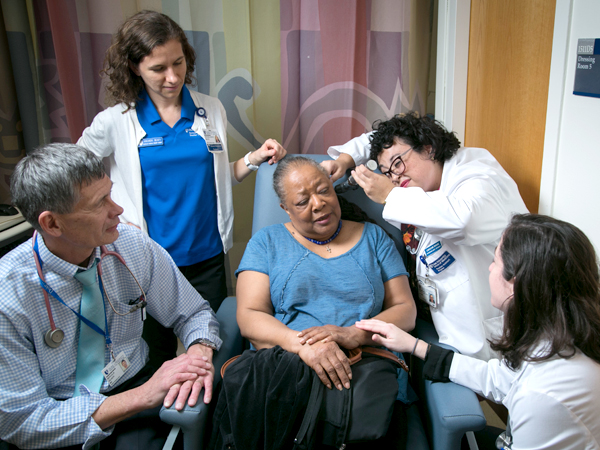*This article was reprinted with the permission of DUSON and the original authors*
The Duke University Direct Observation and Interprofessional Clinic recently treated its 1,000th patient! Duke University schools of nursing and medicine faculty members and students care for patients in this after-hours clinic, which is open four days a week from 5 to 9 p.m.
Launched in 2015, the clinic provides urgent care services to patients from the Duke University Hospital emergency room who present with less acute symptoms and provides students with an opportunity to provide patient care while being observed by faculty members.
“Nursing and health professions students are paired with faculty to care for patients,” said Blanca “Iris” Padilla, PhD, APRN, FNP-BC, assistant professor for Duke University School of Nursing (DUSON). “Working in a collaborative environment is necessary for today’s students, especially with the increased need of a holistic approach to patient care.”

As the health care needs of patients with multiple chronic conditions increase, health care professionals from differing disciplines collaborate to improve health outcomes for patients. There is growing recognition that interprofessional collaboration improves communication and leads to better health care delivery and patient outcomes.
While interdisciplinary collaborations aren’t new to education, especially at Duke, when the clinic opened more than a year ago, Edward G. Buckley, MD, vice dean for Education at the School of Medicine and one of the clinic founders, said he wasn’t aware of any other school in the country being able to successfully launch a similar education-focused clinic.
“This clinic has been vital in placing the learner at the center of the mix of providing exceptional patient care while allowing students from various programs such as nursing and medicine to work together side by side,” he said. When the clinic first started, only nurse practitioner and medical students attended the clinic. Now the clinic is open to students in the Accelerated Bachelor of Science in Nursing (ABSN) degree program as well as physician assistant and physical therapy students who can work for clinical rotation credit.
As the clinic continues to care for patients from Duke’s emergency room, Padilla and Buckley hope to continue its growth by allowing other health professions such as social work to join the interdisciplinary mix.
The Interprofessional Clinic is also a representative on the Duke Health strategic plan by Chancellor A. Eugene Washington. The plan would increase interprofessional education, research and practice at Duke Health. More than 30 faculty representing the Duke University Schools of Nursing and Medicine, convened by Marion E. Broome, PhD, RN, FAAN, Ruby Wilson Professor of Nursing and dean for DUSON, vice chancellor for Nursing Affairs for Duke University, and associate vice president for Academic Affairs for Nursing for Duke University Health System, developed a plan that articulated a vision for the interprofessional education. A vision for health science education programs to collectively, creatively and effectively educate the next generation of health sciences leaders to translate their knowledge into public benefit around the world.
Congratulations to the schools of nursing and medicine faculty and students for reaching this milestone!
Related members
Alison Clay
Adjunct Associate Professor of the Practice of Medical Education
Blanca 'Iris' Padilla
Associate Clinical Professor in the School of Nursing
Brent Theiling
Assistant Professor of Surgery
Jeff Hoder
Associate Professor in Orthopaedic Surgery
Nicholas Hudak
Associate Professor in Family Medicine and Community Health
Lynn Bowlby
Associate Professor of Medicine
Gwendolen Buhr
Associate Professor of Medicine
Lawrence Greenblatt
Professor of Medicine
John Roberts
Assistant Professor of Medicine
Joel Stoia
PA-C Emergency Medicine
Traci Thoureen
Associate Professor of Surgery